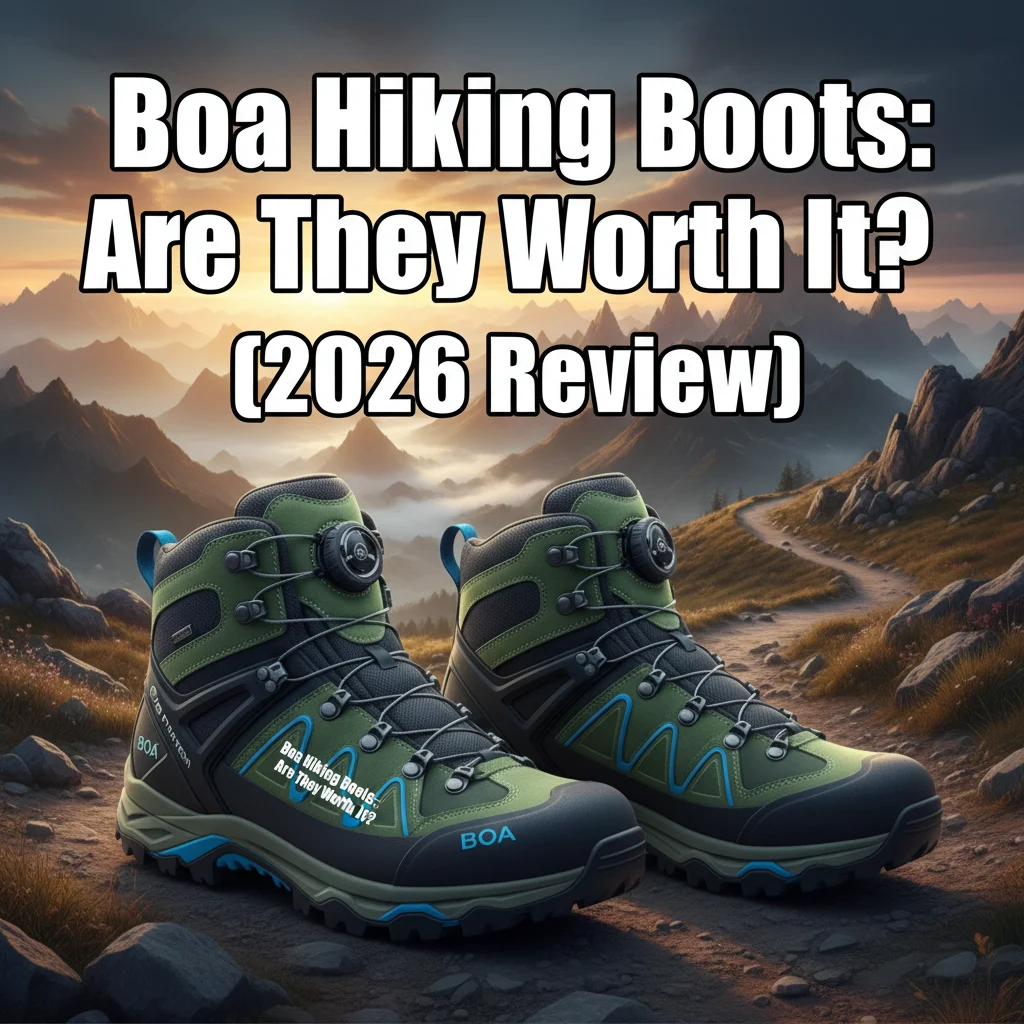[Get the best value boa hiking boots on Amazon today!]
# Boa Hiking Boots: Are They Worth It? (2026 Review)
Hiking is an incredible way to connect with nature, challenge yourself physically, and enjoy breathtaking views. But the wrong gear can quickly turn a dream hike into a miserable slog. Your boots are arguably the most important piece of equipment, and if you’re considering boa hiking boots, you’re probably wondering if they’re worth the investment. In this 2026 review, we’ll dive deep into the world of boa-equipped hiking boots, exploring their pros, cons, and whether they live up to the hype.
### Top Picks Summary
| Boot | Best For |
| :————————————– | :———————————————— |
| Salomon Quest 4D 3 GTX Boa | Rugged Terrain and Backpacking |
| Lowa Renegade GTX Mid Boa | Day Hiking and General Trail Use |
| Merrell Moab 3 Mid Waterproof Boa | Beginners and Those Seeking Comfort |
### Salomon Quest 4D 3 GTX Boa
**Best For:** Rugged terrain, backpacking trips, and demanding hikes where ankle support and durability are paramount.
**Key Features:**
* **Boa Fit System:** Provides a precise and easily adjustable fit, even with gloves on.
* **4D Advanced Chassis:** Offers excellent stability and support on uneven terrain.
* **Gore-Tex Waterproofing:** Keeps your feet dry in wet conditions while remaining breathable.
* **Contagrip TD Outsole:** Delivers exceptional traction on a variety of surfaces.
**Why We Like It:** The Salomon Quest 4D 3 GTX Boa is a powerhouse of a boot, built for serious hikers and backpackers. The Boa system allows for micro-adjustments, ensuring a snug and comfortable fit that minimizes blisters. The 4D Advanced Chassis provides superb stability, preventing ankle rolls on challenging trails. The Gore-Tex membrane keeps your feet dry and comfortable, while the Contagrip outsole offers excellent grip on rocks, mud, and other surfaces. If you’re tackling tough terrain and need a boot you can rely on, the Quest 4D 3 GTX Boa is an excellent choice.
### Lowa Renegade GTX Mid Boa
**Best For:** Day hiking, general trail use, and hikers who want a comfortable and versatile boot.
**Key Features:**
* **Boa Fit System:** Offers a secure and customized fit with easy adjustments.
* **Nubuck Leather Upper:** Provides durability and a classic hiking boot look.
* **Gore-Tex Lining:** Ensures waterproof and breathable performance.
* **Vibram Renevo Outsole:** Delivers excellent traction and shock absorption.
**Why We Like It:** The Lowa Renegade GTX Mid Boa is a classic hiking boot with a modern twist. The Boa system adds convenience and precision to the fit, while the nubuck leather upper provides durability and a traditional aesthetic. The Gore-Tex lining keeps your feet dry in wet conditions, and the Vibram Renevo outsole offers excellent traction and shock absorption. The Renegade is known for its comfort, making it a great choice for day hikes and general trail use. It’s a versatile boot that can handle a variety of terrain and conditions.
### Merrell Moab 3 Mid Waterproof Boa
**Best For:** Beginners, casual hikers, and those seeking a comfortable and affordable boa hiking boot.
**Key Features:**
* **Boa Fit System:** Allows for easy and precise fit adjustments.
* **Waterproof Membrane:** Keeps feet dry in wet conditions.
* **Kinetic Fit ADVANCED Footbed:** Provides targeted support and cushioning.
* **Vibram TC5+ Outsole:** Offers excellent grip and durability.
**Why We Like It:** The Merrell Moab 3 Mid Waterproof Boa is a fantastic option for hikers who prioritize comfort and affordability. The Boa system makes it easy to dial in the perfect fit, while the waterproof membrane keeps your feet dry in wet conditions. The Kinetic Fit ADVANCED footbed provides excellent support and cushioning, making it comfortable for long days on the trail. The Vibram TC5+ outsole offers reliable grip on a variety of surfaces. The Moab 3 is a great entry-level boa hiking boot that delivers excellent value for the price.
[Browse top-rated boa hiking boots on Amazon]
## Buying Guide: What to Consider When Choosing Boa Hiking Boots
Choosing the right hiking boots can be daunting, especially with the added factor of the Boa fit system. Here are some key considerations to help you make the best decision:
* **Fit:** This is paramount. Even with the adjustability of the Boa system, ensure the boot’s overall shape and size match your foot. Try them on with hiking socks. Your toes should have enough room to wiggle, and your heel should be secure to prevent slippage.
* **Intended Use:** Consider the type of hiking you’ll be doing. For rugged terrain and backpacking, look for boots with stiffer soles, ankle support, and durable materials. For day hiking on well-maintained trails, a lighter, more flexible boot may suffice.
* **Waterproofing:** If you hike in wet conditions, a waterproof membrane like Gore-Tex is essential. Ensure the boot is fully waterproof, including the tongue and seams.
* **Ankle Support:** High-cut boots provide more ankle support, which is crucial for carrying heavy loads or hiking on uneven terrain. Mid-cut boots offer a balance of support and flexibility, while low-cut boots are best for easy trails.
* **Outsole:** The outsole is the part of the boot that contacts the ground, so it’s important to choose one that provides good traction on the surfaces you’ll be hiking on. Vibram outsoles are known for their durability and grip.
* **Material:** Leather boots are durable and long-lasting, but they require more break-in time. Synthetic boots are lighter and dry faster, but they may not be as durable. A combination of leather and synthetic materials can offer a good balance of durability and comfort.
* **Boa System Components:** Examine the Boa closure. Is the dial easy to grip and turn? Are the laces durable and resistant to abrasion? Consider the replacement process for laces and dials.
* **Weight:** Lighter boots are less tiring to wear on long hikes. However, lighter boots may not be as durable or supportive as heavier boots.
* **Breathability:** Hiking can be a sweaty activity, so it’s important to choose boots that are breathable to prevent your feet from overheating. Look for boots with breathable membranes or ventilation features.
* **Price:** Boa hiking boots can be more expensive than traditional lace-up boots. Set a budget and compare prices from different retailers.
* **Durability:** High-quality materials and construction will ensure your boots last through many hikes. Check reviews for long-term durability feedback.
* **Boa System Security:** While Boa systems are generally reliable, consider scenarios where the dial might get damaged or the laces might break. Research the brand’s warranty and replacement options.
[Browse top-rated boa hiking boots on Amazon]
## Understanding the Boa Fit System
The Boa Fit System is a closure system that uses a dial, laces, and guides to provide a precise and adjustable fit. Instead of traditional laces, Boa systems use a thin, strong cable that is tightened or loosened by turning the dial. This allows for micro-adjustments, ensuring a snug and comfortable fit that minimizes pressure points and blisters.
**How it Works:**
1. **Dial:** The dial is the heart of the Boa system. Turning the dial clockwise tightens the laces, while pulling the dial out releases the laces.
2. **Laces:** The laces are made of a strong, lightweight material that is resistant to abrasion and stretching.
3. **Guides:** The guides are small loops or hooks that the laces run through, ensuring even distribution of pressure across the foot.
**Advantages of Boa Hiking Boots:**
* **Precise Fit:** The Boa system allows for micro-adjustments, ensuring a snug and comfortable fit that minimizes pressure points and blisters.
* **Easy Adjustment:** The dial is easy to turn, even with gloves on, making it convenient to adjust the fit on the go.
* **Even Pressure Distribution:** The laces distribute pressure evenly across the foot, reducing the risk of hot spots and discomfort.
* **Quick Release:** Pulling the dial out instantly releases the laces, making it easy to take the boots off.
* **Durable:** Boa systems are made of high-quality materials that are designed to withstand the rigors of hiking.
**Disadvantages of Boa Hiking Boots:**
* **Cost:** Boa hiking boots can be more expensive than traditional lace-up boots.
* **Potential for Failure:** While Boa systems are generally reliable, there is a potential for the dial or laces to break.
* **Repair:** Repairing a Boa system can be more complicated than replacing a broken lace on a traditional boot. Usually, you will need to contact the manufacturer for parts.
* **Aesthetics:** Some hikers may not like the look of the Boa system.
[Browse top-rated boa hiking boots on Amazon]
## Are Boa Hiking Boots Right for You?
Whether or not boa hiking boots are right for you depends on your individual needs and preferences. If you value a precise and adjustable fit, easy adjustment on the go, and even pressure distribution, then boa hiking boots may be a good choice. However, if you are concerned about cost, potential for failure, or aesthetics, then traditional lace-up boots may be a better option.
**Consider Boa boots if:**
* You struggle with traditional laces.
* You need to make frequent fit adjustments during your hikes.
* You value a precise and customized fit.
* You hike
[Check the latest prices and deals for boa hiking boots on Amazon today!]







